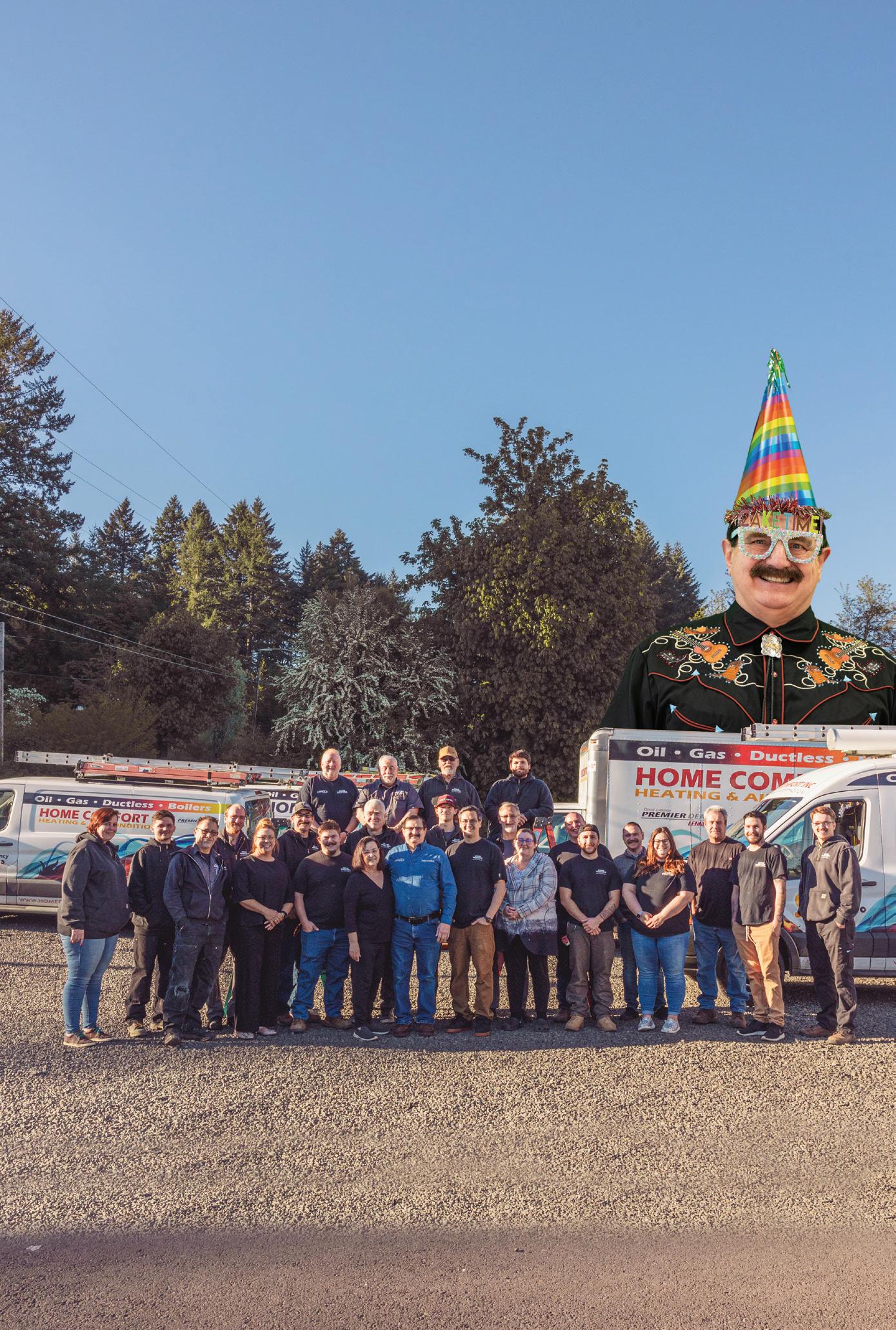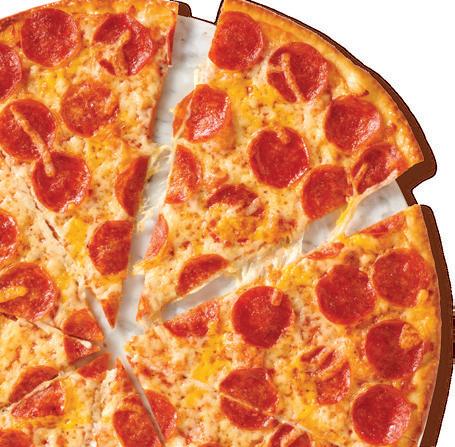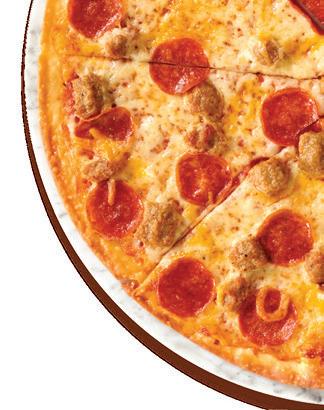




Are


































Are




























HVAC offers a breath of fresh air
By Patti Jo Brooks, Contributing Writer by Laurel Bice“Keeping you comfortable since 1954.”
Home Comfort Inc. celebrates 70 years of the highest quality heating, ventilation and air conditioning (HVAC) services throughout the Willamette Valley. Whether beating the soaring heat of recent summers or the freezing temperatures of winter, Home Comfort Inc. provides individualized options that can keep you and your home feeling perfect all year long. Home Comfort Inc. also specializes in safe air quality and offers a selection of purification systems as well as duct cleaning services to help you breathe easier inside your home.

With summer temperatures reaching triple digits, residents have experienced greater need for adequate home cooling systems. Children, seniors and the increased work-from-home force all need relief from the crippling heat. Air conditioning units to heat pumps and ductless mini splits, Home Comfort Inc. has cooling system solutions for every space and type of home.
In addition to temperature control, air quality, which is all too often overlooked, should be considered as well.
Advancements in technology have created products that can drastically increase air quality in the home. Whether one is suffering from the pollen of the Willamette Valley or smoke and particles from the annual forest fires, Home Comfort Inc. has a system that can “scrub” the air in your home of particulates, allergens and pet dander, leading to cleaner air and better health. Cleaning the home air duct system will also help the quality of air in the home and allow the heating and cooling system to operate more efficiently.

Just like its high-quality equipment, Home Comfort Inc. is a high-quality company that you can trust. Owned by Joe and Vicki Flande along with their son Ben, Home Comfort Inc. employs a professional staff of highly trained and skilled technicians. From appointments to installs to service, maintenance and repairs, Home Comfort Inc. offers clients peace of mind on all their heating and cooling equipment.
Joe Flande professes “it is not about money but people.” In keeping with that, Home Comfort Inc. encourages homeowners to schedule annual maintenance on their heating and cooling system which can increase the life of the system and save money by avoiding costly repairs. It’s also important to have the dryer vent cleaned regularly to reduce the chance of house fires.
Membership programs designed to keep furnaces, heat pumps, air conditioners, tankless water heaters and fireplaces running at their most efficient, trouble-free performance start at just $11 per month. Home Comfort Inc. also offers 24-hour, seven-days-a-week emergency service should you experience a heating or cooling system fail outside of regular business hours.
Home Comfort Inc. is located at 1827 S Main Street in Dallas. Give them a call at 503-623-2341 or visit their website homecomfortinc.com for more information. You’ll be glad you did!



































The first Black resident of Linn County, Oregon was a woman then known only as Cora Ann. She was born into slavery in Virginia between 1822 and 1833, and by 1837 was living in New Orleans, where she was purchased by 32-year-old Emeline Carey Sellick. In 1850, Emeline and Cora moved to Missouri, where Emeline married Samuel Johnson. That same year, the couple moved to Oregon, and Cora traveled with them on the Oregon Trail as an enslaved overland pioneer.
When the Johnson party reached Oregon in the fall of 1850, Cora became one of just 55 Black people in the Oregon Territory. African Americans – free or enslaved – had been legally barred from coming to Oregon since 1849. However, legislation targeting Black people often went unenforced within Oregon’s disparate farming communities. This allowed a handful of Black Americans to remain in Oregon despite their legal exclusion, but it also allowed slavery to continue long after the practice was prohibited. Oregon’s Supreme Court outlawed slavery in 1853; Cora, however, would continue to be held as Emeline’s slave until the 1860s.
Samuel Johnson claimed a 640 acre homestead near Brownsville in Linn County, and built a home which he and his wife shared with Cora. The Johnsons had no children. Samuel Johnson drowned in the Calapooia River in January 1858, leaving Emeline and Cora alone.
In December 1858, Cora married John Cox, a Black farm laborer. Theirs is the earliest recorded marriage of two Black people in Oregon. John Cox worked for Jefferson Huff, a white widowed father of two from Tennessee who was likely John’s former owner. Two months later, Emeline and Jefferson Huff were married, and all began sharing the same home.
Cora and John had a daughter named Adeline in 1860. In that year’s census, Cora and Adeline were listed as slaves, while John was listed as free. A second daughter, Angeline, was born in 1864. Cora was emancipated in or before 1864 as well. That year, Emeline sold her “former servant” Cora 36.3 acres of land from her homestead with Samuel Johnson for just $10.00, in recognition of “faithful services rendered.” This purchase made Cora one of the earliest Black landowners

in Oregon history. John Cox built a home for his family on this land that same year.
Cora remained close to Emeline even after receiving her freedom. In 1866, Cora testified in Emeline’s divorce trial against Jefferson Huff. The testimony of a Black woman was extremely rare in 19th century Oregon.
Cora was well known throughout the Willamette Valley; she and her husband were affectionately called “Aunt Cora” and “Uncle John” by their friends and neighbors. She was wellconnected within the region’s small Black community. Cora attended Oregon’s earliest-known Emancipation Day celebration in Salem in 1867, alongside fellow Black pioneers like Ben Johnson and Amanda Gardner.
John Cox died in 1875, but Cora remained in her home until 1886. She sold the house and land that year for $600 and moved to Brownsville. Cora lived comfortably from the sale of her property for the rest of her life. Sources say Cora even made a monetary gift to Willamette University Women’s College in her will. Cora Cox passed away in 1892. The house she lived in from 1864-1886 still stands today, making it one of Oregon’s oldest homes.

Oregon Black Pioneers is Oregon’s only historical society dedicated to preserving and presenting the experiences of African Americans statewide. To learn more, and to support this nonprofit, visit oregonblackpioneers.org.
Oregon Black Pioneers, 2024









In the months of June and July, join Mattress World Northwest in supporting JoyRx, the mission delivery of Children’s Cancer Association, and bring joy to thousands of seriously ill kids in Oregon.




Why is this nonprofit so important? JoyRx programs are designed to relieve the sadness, anxiety and isolation kids experience during hospitalizations. Through music, nature and mentorship, their no-cost joy-based programming

has been providing emotional healing to children with cancer and other illnesses for over 27 years. JoyRx provides what every parent with a sick child so desperately hopes for — just a little bit of joy to bring light to the dark treatment journey.
Family-owned and -operated, dedicated to providing their customers the best products at the best prices, all while donating to and participating in their local communities, Mattress World Northwest exemplifies the best of what retail businesses have to offer. This proves that not all mattress stores are created equal.
Get a better night’s sleep and help support your local community at the nearest Mattress World Northwest store. They are open every day or you can order online at mattressworldnorthwest.com.
• Recuperate from exercise
• Decompress your back
• Increase circulation
• Address injuries







 By Donovan Darling, Staff Writer
By Donovan Darling, Staff Writer
Father’s Day will be celebrated on June 16 this year. Father’s Day, a holiday celebrated around the world, is a day dedicated to honoring fathers and father figures.
The origins of Father’s Day can be traced back to the early 20th century in the United States. The holiday’s establishment is often credited to Sonora Smart Dodd, who was inspired by the newly recognized Mother’s Day. Sonora, the daughter of a Civil War veteran and single father, William Jackson Smart, wanted to honor her father’s selfless service in the war. So in 1909 she proposed the idea of Father’s Day to local ministers in Spokane, Washington, to be celebrated on June 5, her father’s birthday. However, there wasn’t enough time to prepare for the holiday that year, so the first Father’s Day was celebrated on June 19, 1910.
popular as the holiday became more mainstream and commercial.
In the mid-20th century, the roles of fatherhood began to shift, with an increasing emphasis on fathers being more involved in raising the children and doing more things around the house. This social shift could be seen in how people viewed Father’s Day as a celebration, not only of paternal authority but also of paternal love, care and nurturing.

Father’s Day gradually gained popularity, with several attempts made to establish it as a national holiday. It wasn’t until 1972 that President Richard Nixon officially recognized Father’s Day as a national holiday in the United States, to be celebrated on the third Sunday of June each year.

Throughout its history, Father’s Day underwent several transformations due to cultural, social and economic factors. Initially, it was celebrated with the simple gestures of wearing a red rose to honor a living father and a white rose to honor a deceased father. Greeting cards, often accompanied by gifts and family gatherings, became increasingly
Around the world, Father’s Day has different origins and traditions. In many countries, it’s celebrated on different dates and with varying traditions. For example, in Catholic countries like Spain and Portugal, Father’s Day is celebrated on March 19, coinciding with the Feast of St. Joseph, the earthly father of Jesus Christ. In Germany, Father’s Day, known as “Vatertag,” is celebrated on Ascension Day, with traditions that include men going on hiking trips and pulling wagons filled with beer.
Today, Father’s Day is celebrated worldwide with a variety of traditions, ranging from simple acts of appreciation to elaborate family gatherings, gift-giving and beer-filled wagons (yes, please!). While its commercialization is often criticized, Father’s Day remains an important holiday for expressing gratitude and love for fathers and father figures, honoring their contributions to family and society as a whole.
As a father myself, I wish you and your families a “Happy Father’s Day!” this June.










 ByRobertMatsumura,ContributingWriter
ByRobertMatsumura,ContributingWriter



most realistic, imaginative video games for both consoles and streaming platforms, many enthusiasts are increasingly looking to the past for a familiar, relaxing and affordable gaming experience.

With the dizzying array of tantalizingly new games out there, complete with ultra-high definition graphics and immersive music and storylines, the rising popularity of old low-tech games with pixelated graphics and simplistic controls is a bit of a head-scratcher. In order to wrap one’s mind around this curious phenomenon, it’s important to understand what the term “retro game” refers to. In gaming parlance the term “retro gaming” instantaneously evokes primitive but charming 8-bit graphics, intuitive straightforward gameplay that is addictive and challenging, yet is, at its core, innately simple.
The heyday of these retro games was back in the 70s and 80s when the internet was still a dream, and words like “cell phone” and “streaming” had not yet entered the common lexicon.

experience was to play these games standing up on arcade machines located in pizza parlors, convenience stores and malls across America.
For those of us who grew up during this era the nostalgia factor is immense. As the world continually grows faster and more complex, there is a certain comfort in the return to something familiar. Engaging again with the graphics, sounds and challenges of these simple games has the ability to evoke the past, like a time capsule transporting one back to the days of their youth. Whether rescuing the princess in the various castles of Super Mario Brothers, zapping fast flowing insects in Centipede or defending humanity from invaders from outer space in Galaxian or Space Invaders, engaging once again with these simple yet thrilling games is like reacquainting oneself with an old friend.
Another lure of retro games is their simplicity. Unlike contemporary video games whose complexity often mirrors real life, retro games offer a binary experience that requires minimal decision making and strategizing. In a world where everevolving technology demands increasing levels of expertise and knowledge,



the straightforward gameplay of retro games can be a refreshing change of pace. Basic hand/eye coordination and reaction time are typically the skills required in retro games, versus the detailed storylines and game mechanics common to today’s popular titles.
Aside from nostalgia and relaxing game play, the affordability of retro gaming is also appealing. The expense of today’s popular titles creates a strain on the pocketbook for budget-minded individuals. The inexpensive price of retro games — frequently bundled together at minimal cost — creates a democratizing effect, wherein the vast majority of gamers can afford to participate, rather than only the hardcore few willing to shell out significant dollars to stay up to date on the latest and greatest new releases.
Finally, one cannot discount the aesthetic appeal of retro games with their pixelated graphics and jaunty chiptune soundtracks that impart a certain charm to these old titles. While highly orchestrated


musical scores and jawdropping HD visuals are indeed impressive from a technical standpoint, there are times when simple equates to good. In a sense, retro games are the comfort food of the video game industry. While gourmet cuisine can be an amazing culinary experience, there are times when you simply desire a good old burger and fries. Leaning over a classic arcade machine, joystick in hand, is a completely different experience to gaming online via the latest PlayStation or Xbox console wearing a headset and communicating in realtime with players around the globe. So how has the recent resurgence in retro game popularity affected the gaming industry?

arcade establishments also double as restaurants serving food and beverages to hungry gamers as they strive to save the world from galactic invaders or guide Pacman through a labyrinth of hungry ghosts.

As one might expect, the surging popularity of retro video games has spurred demand for old gaming consoles. The resale market on sites such as eBay for vintage Atari, Nintendo, and Sega Genesis consoles has exploded as the younger generation of gamers discovers these old classics, and Boomers reengage nostalgically with the favorite games of their youth. The demand for retro game
The surging demand for retro games has manifested itself in a myriad of ways, from the creation of small hand-held arcade machines for gamers on the go to the digital remastering of classic retro titles. Game designers are also incorporating visuals, sound effects, and game mechanics from the old retro titles and developing new games that capture the essence of these timeless originals. In cities across the globe the burgeoning demand for retro video games has spawned arcade establishments catering to gamers wishing to play the old classics standing up, on machines like those of their youth. Often these new

in lockstep with the demand for the old consoles and games cartridges, driving a craze for all things retro gaming. No matter what your age or level of gaming experience — Baby Boomer to Gen Z, avid gamer to newbie – retro video games have something to offer everyone. Whether you grew up in the 70s or 80s and seek a nostalgic blast to the past, or hail from a more recent generation, the realm of retro gaming is a wonderful respite from the complexities of our modern life—digital comfort food for the soul!







Hello, friends! Believe it or not, summer is coming, so it’s time to embark on a journey exploring the secrets to crafting a truly inviting outdoor sanctuary. We’ll be unveiling a few of the essential elements that distinguish a lackluster patio from a haven of serenity and joy. Each of these components is a pivotal piece of the puzzle and vital to the success of your project.


1
Nature’s touch matters! Soften harsh textures with plants, transforming your patio into a lush sanctuary
Design your patio to adapt to changing weather! Incorporate shade elements while ensuring ample ventilation for an enjoyable outdoor experience.
Fire pits or outdoor fireplaces create a captivating ambiance, drawing folks together for heartwarming conversations.
Relaxation is key! Opt for cozy, casual outdoor furniture that harmonizes with your patio’s aesthetics and durability
5
Paving stones promise a lifetime of enjoyment, providing durability and timeless charm for your patio surface.

































 By Kelly Romo, Contributing Writer
By Kelly Romo, Contributing Writer
Father’s Day is just around the corner, and what better way to celebrate than with a unique experience filled with family, fun and a touch of heroism? Mark your calendars for June 16 and head to Powerland Heritage Park for a traditional firefighter breakfast and exciting events at the Oregon Fire Service Museum.
The Father’s Day Firehouse Fun event starts with a hearty spread featuring pancakes, eggs, sausage, juice and coffee, perfect for fueling the day’s adventures. Admission to the park is only $10, with an additional $10 for breakfast. For the little ones, admission is $5, with breakfast priced at $5. Children aged four and under get in free! Additional discounts apply for first responders, veterans and active, making it an excellent opportunity to show appreciation for our everyday heroes.
Once you’ve fueled up, it’s time to dive into the festivities. The museum, which is still under construction, will have the front gallery open so guests can see fire apparatus’ more than 100 years old. This is a rare opportunity to get up close and personal with these historical artifacts. Marvel at the apparatus from Marion Co. Fire 1 and listen to the

captivating roar of old fire trucks starting up. Guests can also sit in a Ford Model T for a fun photo opportunity. Behind the museum, you can see old fire trucks currently under restoration. Weather permitting, you might even catch Life Flight landing in the back field, a sight that will awe young and old alike.
After the events and seeing the progress of the construction of the Oregon Fire Service Museum, you can spend the entire day exploring the 14 partner museums scattered throughout Powerland Heritage Park. Each museum offers a unique perspective on history and innovation, from steam-powered machinery to trains, trolleys, logging equipment and farm implements. The park is large, so kids are invited to bring their ride-on power wheels to cruise around, adding extra excitement for them. When hunger strikes later in the day, visitors can grab lunch from one of the food carts brought in specifically for this event. They will start serving at 11 o’clock.

Remember, the Father’s Day Firehouse Fun event is not just a celebration; it’s a crucial fundraiser for the fire museum. Your participation is not only fun but also meaningful. By attending, you directly support the noble cause of the Oregon Fire Service Museum Memorial & Learning Center, which is dedicated to preserving and sharing the rich heritage of firefighting in Oregon.

So mark your calendars, gather the family and head down to Powerland Heritage Park on June 16 for a Father’s Day celebration that’s perfect for all ages. With delicious food, exciting activities, and the chance to support a worthy cause, it’s bound to be a day to remember.
For more information or to purchase tickets, visit oregonfiremuseum.org/fathers-day-firehousefun/ or call ahead at 888-313-6873. The museum is located at Powerland Heritage Park, 3995 Brooklake Road, N.E. Salem.























The world is full of stories about people who start their journey on one path only to find themselves on another. When Maggie Pike sold her successful bakery, Maggie’s Buns, she thought she would be bored. But instead, she fell back in love with pottery, a craft she had dabbled in thirty-two years earlier. Now, she makes vibrant creations that are not only utilitarian but also beautiful works of art.
When asked what drew her to pottery, Maggie admits she used to be terrible at it, but had always enjoyed it. After selling her bakery, she longed for something creative to do, so she dug out her old potter’s wheel and gave it a spin. To Maggie’s surprise, she got it right on the first try, and that was all it took to reignite her passion.

The colors Maggie discovers on her travels inspire the forms and textures of her pottery. She sifts through photos from her latest trip, selects about ten colors, and starts creating. Her glazing process involves up to seventeen hand-painted layers, each adding depth and personality to her creations. Even Maggie doesn’t always know what the final product will look like, but the unexpected results are part of the fun.
The process of creation holds its own magic for Maggie. Unveiling a new design from her kiln, fondly named “Calvin,” is always thrilling. Nearly 30% of pottery is lost in the kiln due to various factors, so she feels an indescribable sense of accomplishment when a piece turns out exactly as she dreamed. Despite years of experience, she never quite knows how a piece will look after it’s glazed, so it’s
nothing short of magical when her vision comes to life.
Maggie found an intimate connection between her love for food and creating practical and visually appealing creations. Her work is a tribute to the moments that often go unnoticed yet hold profound significance, like sipping hot coffee from a beautifully crafted mug or enjoying a homecooked meal in a hand-thrown bowl. This is her way of spreading joy, and she finds inspiration in the thought that her creations might make someone’s day a little brighter. She hopes this cycle of inspiration — where the excitement of her audience fuels her creative energy — continues to thrive, enabling her to create art that brings smiles and warmth to people’s lives. If you eat off something every day, it might as well be a work of art!

Valley Arts Association has profoundly impacted Maggie’s artistic journey. The familiar faces and warm appreciation of the local community foster confidence and inspire her to experiment with her artistic style. Valley Art’s vibrant culture and lively environment have also provided ample opportunities for networking and collaboration. Moreover, Valley Art’s website serves as a hub for upcoming events, allowing her to stay connected to the local art scene, discover new inspiration, and showcase her creations.


Maggie’s journey to becoming a potter was unexpected, but it has led to some truly stunning work. Her use of color and hand glazing has made Maggie’s pieces into unique and beautiful works of art that people can enjoy. If you’re looking for something functional and artistic to add to your home, you can’t go wrong with one of Maggie’s creations.
To see more of Maggie’s work, check out her Facebook pages under ‘Maggie Pike’ or ‘Passport to Color.’ You can also see her creations at Valley Art at 2022 Main Street in Forest Grove, (503) 357-3703 or on their website at: www.valleyart.org
8 Rooms or 800 sq ft (Saving $90) Not valid with any other offer. Expires 7/31/24

4


